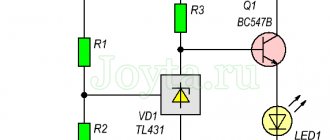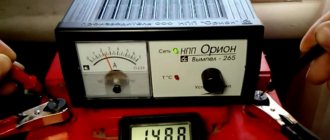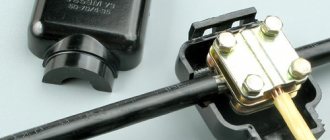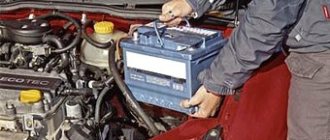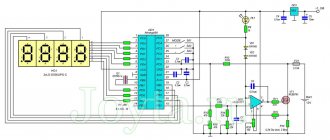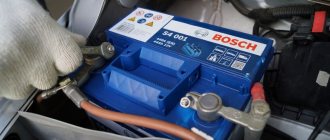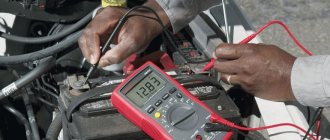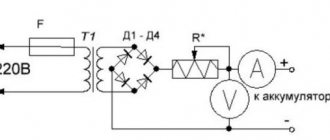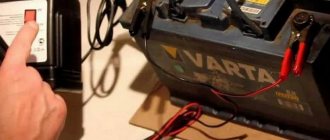Battery power sources are reusable chemical sources. Their work is based on reversible chemical processes that occur differently during charge and discharge. Since the chemical components are not absolutely pure, and the reactions are quite complex, during operation the primary composition of the elements changes, and the battery is no longer able to provide the original capacity.
Car battery
Design and operating principle
Lead-acid batteries use a reaction between lead and sulfuric acid to operate. The composition of the anode and cathode plates is different:
- Anode – lead dioxide PbO2;
- Cathode – lead sponge (to increase the effective area).
Internal organization
During the discharge process, reactions of the cathode and anode substances occur. On both electrodes, lead compounds form with the electrolyte (an aqueous solution of sulfuric acid). As a result of the formation of lead sulfate, the amount of sulfuric acid in the solution decreases and its density decreases.
During charging, a reverse reaction occurs, resulting in the formation of lead dioxide at the anode and lead at the cathode. The acidic residue goes into solution and its density increases.
Ideally, such reactions can continue indefinitely, but due to various factors, the battery capacity decreases over time because the reactions do not occur completely.
Reasons for natural polarity reversal
Battery recovery
As a result of regular deep discharges, when operating at high temperatures, large crystals of lead sulfate are deposited, which do not fully participate in chemical reactions due to their size. Over time, the number of such crystals increases, and the battery capacity decreases. This process is called sulfation.
Sulfation of plates
Sulfation is the main reason for a decrease in battery capacity and an increase in internal resistance. Large sulfate crystals destroy the material of the plates, which leads to their shedding and interelectrode short circuit. Ultimately, the battery becomes completely unusable.
At a certain moment, the amount of lead sulfate on one of the electrodes may exceed the norm, and a change in polarity will occur, that is, when measuring the residual voltage, a minus is formed at the anode, and a plus at the cathode. This phenomenon is called battery polarity reversal.
When charging such a battery, the polarity reversal is eliminated at the initial moment of time, then the charging process itself begins.
What problems might you encounter?
The final consequences can be completely different. Polarity reversal is usually performed in the case of moderate sulfation of the plates. For example, in most cases, cheap batteries cannot be restored due to the fact that their plates are of frankly low quality. Also, reversing the polarity will not help when:
- one of the plates crumbled;
- There is a cloudy electrolyte inside the cans;
- There is not enough density inside the battery.
Attention! Therefore, before performing the procedure, it is recommended to check the battery for problems in the banks, make sure that they are clean and transparent, when there is only a slight white coating on the surface. In such situations, polarity reversal is acceptable.
What is the danger of polarity reversal when lighting a cigarette?
When the battery capacity is lost, especially in winter, they often resort to “lighting up”, when the dead battery is connected using extension wires to another car with a normal battery. The capacity is partially restored and the engine starts.
Lighting up the car
If, during a deep discharge, a spontaneous polarity reversal occurs, then the batteries of two cars are turned on in opposite directions, which is fraught with failure of a serviceable battery due to a sharp increase in the discharge current.
Important! If there is a complete discharge, it is necessary to check for polarity reversal with a voltmeter. You cannot light a car with a faulty battery.
What are the consequences for a car owner when the polarity is reversed?
It is important to remember: the design of the car assumes the use of only batteries of a certain size and terminal location. It is possible to install a battery of similar capacity, but not the correct polarity, into the seat. But it will no longer be possible to connect it in standard mode. Because the wires simply won't reach.
It is no coincidence that such a difference between batteries is present: incorrect polarity will cause damage to the car’s electronics. The engine control unit may fail and a short circuit may occur. It is important to remember: not all electrical appliances fail when changing poles. But many will be damaged. Such situations should be avoided.
Moreover, in some cases, the holes in the terminals are even different. Usually the diameter of the positive one is slightly larger than the negative one. Therefore, it will be difficult to confuse them even by accident. Moreover, changing the poles can cause the starter to rotate in the other direction. Some engines may require major overhaul after this.
We recommend: Motor oils and everything you need to know about motor oils
How to reverse polarity of a battery
To perform polarity reversal, it is necessary to charge by changing the polarity, that is, by connecting the positive pole of the charger to the cathode of the battery, and the negative (ground or ground) to the anode.
Since changing the polarity of the battery is an extreme measure, the most important thing is to comply with safety regulations, since the safety of the battery is no longer a question.
Note! Only those devices whose performance deteriorated more or less equally in all banks are subject to polarity reversal. An uneven change in the density of the electrolyte or increased boiling in one of the cans indicates a short circuit or break. There is no point in restoring such batteries, since the likelihood of normalization is close to zero.
The procedure for changing the polarity is as follows:
- Completely discharge the battery using a load. You can use a 12-volt car lamp as a load. As a guaranteed measure, after the end of the discharge, you need to short-circuit the battery terminals for a while. The voltage is checked using a magnetic or digital voltmeter.
Important! Do not short-circuit the terminals of a battery that is not completely discharged. There is a high probability of shedding of the active mass of the plates.
- Level the density and level of the electrolyte.
- Connect the charger with reverse polarity and set the current to no more than 2-3 A, since the polarity reversal reaction can cause strong heating.
- The end of the charge is indicated by boiling of the electrolyte.
Note! Boiling is a slang expression. In fact, oxygen and hydrogen are released at the electrodes as a result of the electrochemical decomposition of water.
Location of current carrying elements
Most often you can find two combinations of terminal locations. This is the polarity, which can be:
- Direct, when the positive terminal is on the left and the negative terminal on the right. Sometimes this distribution of current outputs is indicated by one, which can often be seen on batteries from domestic manufacturers. Finding the markings is quite simple; just turn the battery face down so that the current carrying elements are located at the bottom. If the plus is on the left, then it is straight polarity. Such batteries are installed on Russian cars. A striking example is Priora.
- Reverse, when the positive terminal is located on the right and the negative terminal on the left. Often this type of polarity is designated zero, which is considered a purely European development. The process of finding information about the location of the poles is the same. If the minus is on the left side of the label, this indicates reverse polarity of the battery. Most often, such batteries are found in foreign cars.
How to distinguish batteries
Often in the conversations of car enthusiasts the phrase about the mythical Asian and American polarity pops up. In fact, these are rumors: such things do not exist in nature. Most likely, the concept of location of current leads is confused with battery sizes. Asian-type batteries are distinguished by more compact sizes, the absence of a protrusion on the top cover of the device, and thin terminals. American batteries also have characteristic features - the location of current-carrying parts on the top panel.
As for the polarity of the battery, Russian and European can be easily distinguished by the location of the terminals or markings (0 and 1). Otherwise, the layout, box dimensions, number of cans and other external features are identical, so even an experienced motorist can get into trouble without looking at the label. In order not to guess, it’s easier to contact the seller, who will select a battery that matches a particular car brand.
Batteries for trucks
The terminal arrangement system on batteries for trucks is not much different from cars. Both terminals are on one of the short sides of the box. Determining the polarity of the battery is simple; you need to look at the location of the terminals:
- If the current terminal marked “+” is on the left side, then this is reverse (European) polarity, which can also be marked with a three.
- If the positive current-carrying element is placed on the right, then this is direct (Russian) polarity. Some manufacturers may designate it as a four.
Frequently, batteries for trucks are found with a layout that is marked with the number 2. In this case, the terminals are located diagonally on the top panel.
Trucks can be equipped with one of two types of batteries, but the terminals are usually located on one of the short sides. In this case, you can also determine whether the polarity of the battery is direct or reverse visually:
You need to turn the battery so that it faces the viewer with the side on which the terminals are located and pay attention to which of the current leads will be on the left and which on the right. If the “plus” is on the left, then this is reverse polarity, which in the case of trucks is often called European. The number “3” was chosen to designate it. If there is “minus” on the left and “plus” on the right, this is straight polarity, which can also be called Russian
Such batteries are marked with the number “4”.
So, the two polarities of batteries for passenger cars are designated by the numbers “0” and “1”. To designate batteries designed for installation in trucks, the numbers “3” and “4” are used.
Uncommon battery types
There are batteries that are designated by the number “2”, but they are not used so often. The arrangement of the current leads on them can be called diagonal: in one corner on the top cover there is a terminal with a minus sign, and in the opposite corner there is a terminal with a plus sign. In this case, the surface of the cover can be compared to a boxing ring, and the terminals themselves can be compared to boxers at the beginning of a round.
It is also worth mentioning two less common types, which are marked with the numbers “6” and “9”. If a six is indicated, it means that the terminals are located on the cover in two corners, but not in opposite, but in adjacent ones. If a nine is indicated, then the “plus” and “minus” are opposite each other.
Rate this article:
Tips for do-it-yourself polarity reversal
Before planning work, you should remember that it is impossible to restore a car battery with the following symptoms:
- Short circuit in one or more banks;
- Broken plates;
- Cloudy electrolyte (evidence of shedding of the active mass);
- Large size electrolyte density.
Shedding of plates
Before you start experimenting with the battery, you need to try to restore its performance in the classic way: carry out a charge-discharge cycle several times in a row. Only if this measure does not give a positive result, and the elimination of sulfation has not occurred, can a polarity reversal be performed.
To equalize the density, distilled water is used, but if the density is low in only one jar, then battery electrolyte can be added there.
Important! If a positive result is achieved, it is necessary to reliably mark the terminals, since the consequence of incorrect connection is failure of the vehicle’s electrical equipment, which is many times more expensive than a new battery.
Reversing the battery polarity is an extremely necessary measure, which can only be resorted to if it is impossible to install a new battery. Long-term operation of a restored device cannot be guaranteed; it must be replaced at the first opportunity.
Differences in the body
All batteries can be divided into:
- domestic;
- European;
- Asian.
They have their own production standards and pin locations. European batteries are usually more ergonomic and compact. The output contacts have a larger diameter. Plus – 19.5 mm, minus – 17.9 mm. The diameter of the contacts on Asian batteries is much smaller. Plus – 12.7 mm, minus – 11.1 mm. This also needs to be taken into account. The difference in diameter also indicates the type of polarity.

